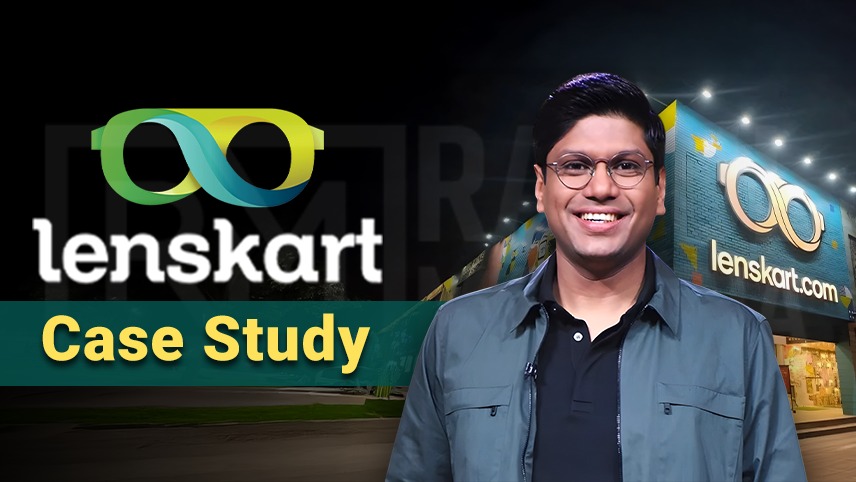
How Lenskart Built a Hybrid Retail Empire in the Eyewear Space
It all began with a question: Why is buying glasses still such a pain?
For years, walking into a traditional optical store meant standing under dull white lights, dealing with a limited stock of frames, and being sold overpriced lenses by a salesperson who barely explained what you were buying. There was no convenience, no clarity, and certainly no charm. In 2010, a young entrepreneur named Peyush Bansal saw this problem not as a hurdle, but as an opportunity to change how India sees, literally.
But how did a modest eyewear startup become a hybrid retail empire? How did Lenskart manage to blend the online and offline world so seamlessly that it became the go-to name for millions of Indians needing spectacles, sunglasses, or contact lenses?
Let’s dive into the gripping journey of how Lenskart disrupted the eyewear industry and built a business model every Indian entrepreneur should learn from.
The First Vision: Seeing a Broken Market
When Peyush Bansal returned to India after studying in Canada and working at Microsoft, he didn’t immediately jump into the eyewear space. He began with other ventures, some failed, some clicked,but it was only when his father started facing issues buying quality spectacles that the idea for Lenskart truly took root.
The Indian eyewear industry was scattered, unorganized, and shockingly underserved. Millions of people either didn’t wear spectacles or wore poor-quality ones because good options were expensive or hard to find. Bansal realized that if you could simplify the process of buying eyewear, offer affordable pricing, and bring transparency into the equation, you could revolutionize the space.
But he didn’t just build an e-commerce site. He built something far more powerful.
Why Just Online Wasn't Enough
In the early days, Lenskart’s business model looked simple: sell glasses online and deliver them to the customer’s doorstep. The platform allowed users to upload their prescription, choose from a wide variety of frames, and get their glasses delivered, often at half the price of a local optical store.
For many urban users, this was a game changer. But there was a catch. Eyewear is a very personal product. People want to see how they look. They want someone to guide them. And not everyone is comfortable uploading prescriptions or measuring pupillary distances at home.
That's when Lenskart’s hybrid retail strategy came into play. Instead of being just another online store, Lenskart decided to meet customers where they were, both digitally and physically.
The Hybrid Leap: Retail, But Reinvented
Most people thought e-commerce was going to kill physical retail. But Lenskart flipped the script.
They didn’t open showrooms like traditional brands. They opened experience centers. Lenskart stores were smart, tech-enabled spaces where customers could walk in, get a free eye test, and try on dozens of frames, not just physically, but virtually too. Augmented reality tools let users see how frames would look from every angle. Store staff weren’t pushy salespeople; they were trained style consultants.
This clever move gave Lenskart a new edge. They captured not just the online-savvy customer, but also the offline walker-by. Slowly, their hybrid model started expanding across cities, towns, and even tier 2 and 3 markets.
And it wasn’t just about visibility. This physical presence built trust. A brand you could walk into felt real. It felt safe.
Tech-First, Not Just Eyewear-First
What set Lenskart’s business strategy apart from the competition wasn’t just eyewear. It was technology. Every part of the business was powered by smart systems, from how inventory was managed to how prescriptions were stored, and even how home eye check-ups were scheduled.
They launched a home eye test service using trained optometrists and portable equipment. They built a face-scanning tool to recommend the best-fitting frames. They personalized frame suggestions using AI. Even their factories were powered by robotic lens manufacturing to maintain precision.
This isn’t your dad’s spectacle shop. This is retail driven by algorithms, machine vision, and customer data, all designed to delight the customer.
Customer Obsession: The Heart of the Empire
While tech gave it wings, it was customer obsession that kept the brand soaring. Lenskart knew that people hate buying specs, not just because of price, but because it feels like a chore. So they made it delightful.
They offered free trials at home. Easy exchanges. Speedy delivery. Stylish frames that felt more like fashion than necessity. And an emotional connection that made buyers feel they were being cared for, not sold to.
One of the smartest moves? The “Gold Membership”, a loyalty plan that gave customers massive discounts, early access to collections, and priority services. This made new customers stick with the brand for the long run.
Lenskart’s marketing strategy also leaned into relatability. Ads were crisp, humorous, and spoke directly to the audience. They didn’t pitch eyewear. They pitched confidence.
The Power of Franchising Smartly
As the brand started opening hundreds of stores, it didn’t follow the usual franchise model. Instead, Lenskart created what it calls a tech-enabled franchise model, where franchise partners benefit from Lenskart’s central inventory, customer data, supply chain, and marketing muscle.
This removed the usual friction of retail expansion. The result? More than 1,500 stores across India, with more opening soon.
This isn’t accidental growth. It’s the result of a solid Lenskart business plan, which merged control with scale, and ambition with customer love.
Global Dreams, Indian Roots
Today, Lenskart isn’t just an Indian phenomenon. The brand is slowly entering markets in Southeast Asia and the Middle East. It acquired brands like Owndays and expanded its international footprint while keeping the Indian customer at the heart of its innovation.
What’s inspiring is that even as it becomes a global brand, Lenskart’s India strategy remains deeply rooted in local insights. They understand that a customer in Mumbai wants something different from a buyer in Patna. And they design for both.
This mix of global aspiration and local execution is what gives Lenskart an edge few can replicate.
The Mindset That Built an Empire
If you look beyond the tech, the funding rounds, and the slick stores, you’ll find a simple truth behind Lenskart’s rise: a mindset of solving real problems. Peyush Bansal wasn’t chasing trends. He was obsessed with fixing broken customer experiences.
Every part of the business, from pricing to logistics to design, was built to reduce friction and add joy. And that’s what makes Lenskart’s business model not just smart, but deeply human.
This is a masterclass in entrepreneurship. One that proves you don’t need to be in a “cool” industry to build something iconic. You just need to listen, adapt, and never stop solving for the customer.
What Aspiring Entrepreneurs Can Learn
If you're building a brand in India today, Lenskart’s journey offers goldmine lessons. Solve real problems. Use technology smartly. Be omnipresent. Build trust. And most importantly, think long-term.
Your market may be unglamorous. But if you serve your customer better than anyone else you could build the next retail empire.
Not all empires wear a crown. Some wear glasses.
Final Thought
The next time you walk into a Lenskart store or browse their app, remember you're not just seeing frames. You're seeing the future of Indian retail. A future that’s hybrid, human, and filled with vision.
Frequently Asked Questions (FAQs)
1. What helped Lenskart rise to the top in the eyewear market?
Lenskart became a leader by solving real problems. It made eyewear affordable, accessible, and stylish. Instead of sticking to the old retail model, it created a powerful hybrid retail empire that gave customers the best of both online convenience and offline experience. With cutting-edge tech and a deep focus on customer happiness, it transformed the way India buys glasses.
2. What makes Lenskart’s business model different from other optical brands?
What sets Lenskart’s business model apart is its blend of technology, smart logistics, and a hybrid retail strategy. While most brands stick to either online or offline, Lenskart built both and connected them seamlessly. From AI-based face scanning to home eye tests, it’s more than just eyewear; it’s a full customer experience.
3. How has Lenskart’s marketing strategy helped it grow so fast?
Lenskart’s marketing strategy focused on keeping things real, simple, and funny. Its ads speak directly to customers without being boring. More than just selling glasses, the brand sells confidence and lifestyle. This emotional storytelling, combined with loyalty programs like Gold Membership, helped turn one-time buyers into loyal fans.
4. What key idea shapes Lenskart’s business model?
At the heart of Lenskart’s business strategy is one idea: solve problems that matter. Whether it’s poor access to eye care, high prices, or boring frames, Lenskart found smart ways to fix them all. It used tech not just for show, but to actually make things easier for customers. That’s how it built long-term trust and a strong brand.
5. How does Lenskart’s business plan support its rapid growth?
Lenskart’s business plan focuses on scale without losing quality. It partnered with franchises smartly, backed by its central tech and inventory systems. This allowed the brand to grow fast without becoming chaotic. And by offering services like home eye tests and free trials, it kept customer satisfaction high which kept the business moving forward.
6. Is Lenskart only for urban customers?
Not at all. While Lenskart started with metro cities, its hybrid retail empire now includes tier 2 and 3 towns across India. The brand understands the different needs of different regions and adapts accordingly. Whether you're in Delhi or Dehradun, there’s a Lenskart experience waiting nearby, online or offline.
7. What can Indian entrepreneurs learn from Lenskart?
One big lesson is that even a boring-sounding product like spectacles can become exciting if you solve real problems. Entrepreneurship isn’t about flashy ideas. It’s about fixing broken experiences. Lenskart proved that with the right mix of tech, trust, and customer love, you can build a massive retail empire out of something as simple as eyewear.
- Business Case study
- Investment Ideas
- Personal Development
- Businessman






